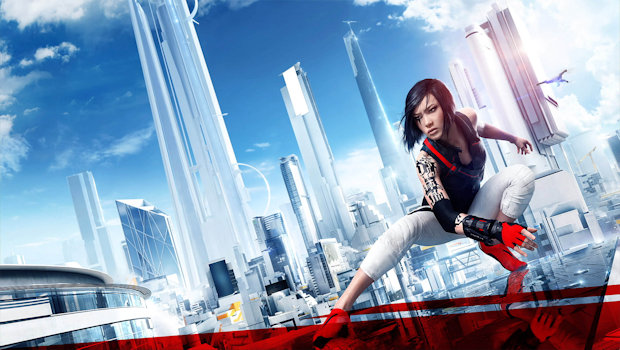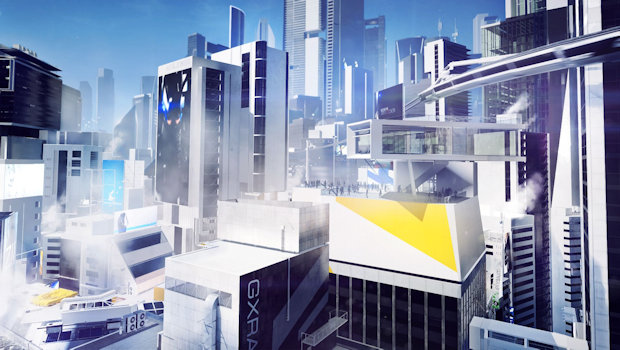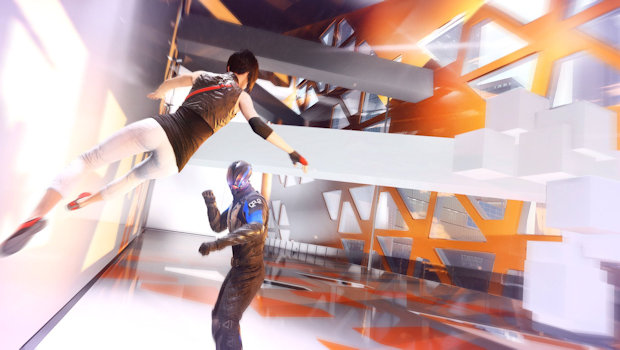When Mirror’s Edge originally released, it was something different. Set in a dystopian corporate run world, it was a bright and colorful first person game in a sea of dark war-themed FPS titles. Its focus was on fast movement and environmental traversal, instead of high body counts. It had its problems for sure, with combat being a huge issue for a great many players, but it was a game that showcased a ton of potential. However, despite selling over 2 million copies, developer DICE has taken 8 years to return to the world of Mirror’s Edge.
I’m sure there are many legitimate reasons why it has taken this long to get back to running across rooftops but it doesn’t change the fact that a lot of time has passed since we first and last saw Mirror’s Edge. A number of different games have come out since then. Storytelling has evolved. Color palettes have expanded. And the movement and traversal system that was so different at the time has been adapted by some of the biggest games in the industry.
DICE, for whatever reason, finally decided it was time to return to running and have given us Mirror’s Edge: Catalyst. Despite being called a prequel at times during its development, Catalyst is very much a reboot. For players of the original game, the events of this new game change aspects of Faith’s story from that one to the point that it’s better to just forget about anything you may have remembered about the original story. With that in mind, Catalyst introduces you to Faith as she is being released from a juvenile detention center. Why she was there is of little consequence because within moments of being released you are back to being on the wrong side of the law.
There is a story that ties Mirror’s Edge: Catalyst together. It involves big corporations plotting to do really bad things, resistance fighters that are an overt terror cell, and familial ties that muddy the waters for Faith. It’s all pretty goofy and made doubly so by the silly dialog and uneven delivery of that dialog. Twists and reveals are so foreshadowed that they hold no weight and fail to deliver the emotional impact they so clearly are aiming for. In short, despite the cool world DICE has manufactured, the story is a bit of a mess.
This doesn’t forgive the weak storytelling but the story in the original Mirror’s Edge wasn’t anything to write home about either; what was delivered with Catalyst was kind of expected. Fortunately Catalyst also delivers what was expected in the gameplay department. Mirror’s Edge: Catalyst is everything its momentum based, free-running, first person platformer precursor was. And then some.
Mirror’s Edge: Catalyst is the original blown out bigger than one could have anticipated. The shift from the very linear delivery of the original game to an open world with Catalyst is one that works perfectly. What DICE has done with building this world is nothing short of breathtaking. If you enjoyed the original’s puzzle solving parkour elements, Catalyst will most likely make you extremely happy. Instead of trying to figure out the one path that DICE had designed for each level of the original, Catalyst lets you blaze your own trail. There still is the tightly designed path, and this is designated by Faith’s red runner’s vision. But, sometimes, (oftentimes for anything outside main missions) this path is not the best or fastest path to take. Discovering alternate routes and learning how to traverse them on the fly is a huge part of Catalyst and is required for success in many of the numerous side missions the game has to offer.
The main narrative missions are almost all expertly crafted and feature some very tricky platforming elements that when hit upon just right make you feel like a superstar. And there are numerous segments that outshine the best levels of the original. This is all great and makes Catalyst super enjoyable. When it works. Unfortunately Catalyst suffers from some of the same issues its predecessor did with these same type of sequences. While hitting them just right is a great feeling, faltering can be a super frustrating experience because it often means instant death for Faith. Catalyst is a bit more forgiving than Mirror’s Edge was, but still once the momentum is broken the game stumbles and becomes less engaging. Even more so if you happen to die. Whereas dying in the original Mirror’s Edge broke the flow of the game, at least you were quickly dumped back into the game to try again. Catalyst’s load times are considerably longer and rinsing and repeating is a bit more of a slog.
I died a lot on some of the more complex segments and my experience with the game was mostly, “Damnit!”, “Fuck!”, “Damnit!”, “Oh God I hate this game!”, “Fuck Yes, I am a parkour God!” It is undoubtedly a flow anyone that has played games has experienced at one time or another but it was a pretty constant cycle for me with this game.
The game doesn’t help itself any by dumping loads and loads of enemies on you to defeat in the final quarter of the narrative. Much like the original game, combat can quickly break the flow of the game and while in the open world you can often choose not to engage in combat, narrative missions often put you in situations where you need to clear all of the enemies in an area out before being able to proceed. Combat has been much improved over the eight years since the original game but it still has major issues that stem from the fact that Faith is not really a fighter. The game has incorporated one hit takedowns that flow from Faith’s movement but much like traversal, if that momentum breaks you are in a really bad place. Missing a jump and a takedown means having to face off against enemies that are stronger than Faith and potentially have projectile weapons that can hit you at range while engaged with other enemies.
Much like the original game, these issues are going to frustrate players to varying degrees. For me, the feeling of finally getting it right trumped all the anger and frustration I had getting there with combat and traversal. But I can also see where someone else might feel the reverse. That makes Mirror’s Edge: Catalyst a very hard game to recommend to just anyone. As a fan of the original, Catalyst does everything I wanted from a sequel and more. There is a ton of side missions to do, tons of collectibles to find, and a host of user-generated races to be done, either during your campaign run or after. And doing all of it will take you between 20-30 hours of play. It’s a beefy game. But it’s also very much a Mirror’s Edge game. Take from that what you will.



